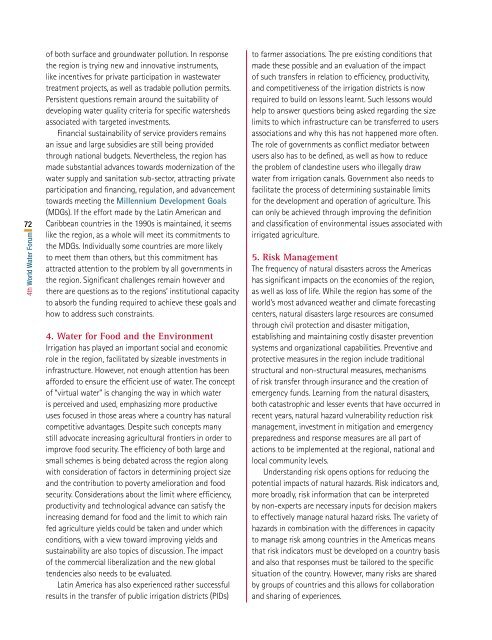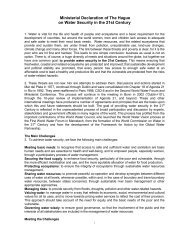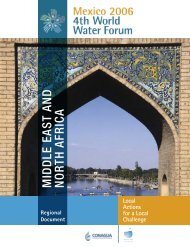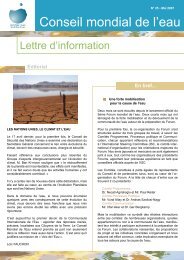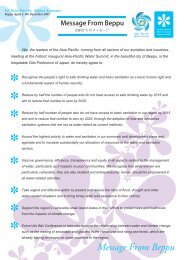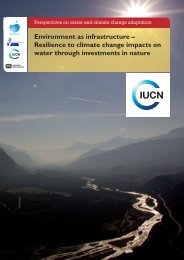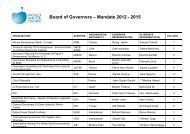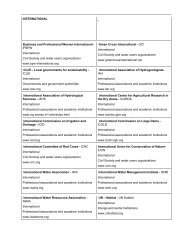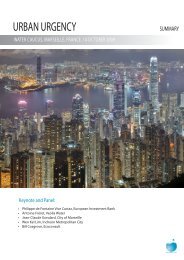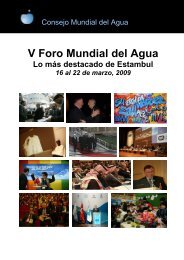Americas ok.indd - World Water Council
Americas ok.indd - World Water Council
Americas ok.indd - World Water Council
Create successful ePaper yourself
Turn your PDF publications into a flip-book with our unique Google optimized e-Paper software.
724th <strong>World</strong> <strong>Water</strong> Forumof both surface and groundwater pollution. In responsethe region is trying new and innovative instruments,like incentives for private participation in wastewatertreatment projects, as well as tradable pollution permits.Persistent questions remain around the suitability ofdeveloping water quality criteria for specific watershedsassociated with targeted investments.Financial sustainability of service providers remainsan issue and large subsidies are still being providedthrough national budgets. Nevertheless, the region hasmade substantial advances towards modernization of thewater supply and sanitation sub-sector, attracting privateparticipation and financing, regulation, and advancementtowards meeting the Millennium Development Goals(MDGs). If the effort made by the Latin American andCaribbean countries in the 1990s is maintained, it seemslike the region, as a whole will meet its commitments tothe MDGs. Individually some countries are more likelyto meet them than others, but this commitment hasattracted attention to the problem by all governments inthe region. Significant challenges remain however andthere are questions as to the regions’ institutional capacityto absorb the funding required to achieve these goals andhow to address such constraints.4. <strong>Water</strong> for Food and the EnvironmentIrrigation has played an important social and economicrole in the region, facilitated by sizeable investments ininfrastructure. However, not enough attention has beenafforded to ensure the efficient use of water. The conceptof “virtual water” is changing the way in which wateris perceived and used, emphasizing more productiveuses focused in those areas where a country has naturalcompetitive advantages. Despite such concepts manystill advocate increasing agricultural frontiers in order toimprove food security. The efficiency of both large andsmall schemes is being debated across the region alongwith consideration of factors in determining project sizeand the contribution to poverty amelioration and foodsecurity. Considerations about the limit where efficiency,productivity and technological advance can satisfy theincreasing demand for food and the limit to which rainfed agriculture yields could be taken and under whichconditions, with a view toward improving yields andsustainability are also topics of discussion. The impactof the commercial liberalization and the new globaltendencies also needs to be evaluated.Latin America has also experienced rather successfulresults in the transfer of public irrigation districts (PIDs)to farmer associations. The pre existing conditions thatmade these possible and an evaluation of the impactof such transfers in relation to efficiency, productivity,and competitiveness of the irrigation districts is nowrequired to build on lessons learnt. Such lessons wouldhelp to answer questions being asked regarding the sizelimits to which infrastructure can be transferred to usersassociations and why this has not happened more often.The role of governments as conflict mediator betweenusers also has to be defined, as well as how to reducethe problem of clandestine users who illegally drawwater from irrigation canals. Government also needs tofacilitate the process of determining sustainable limitsfor the development and operation of agriculture. Thiscan only be achieved through improving the definitionand classification of environmental issues associated withirrigated agriculture.5. Risk ManagementThe frequency of natural disasters across the <strong>Americas</strong>has significant impacts on the economies of the region,as well as loss of life. While the region has some of theworld’s most advanced weather and climate forecastingcenters, natural disasters large resources are consumedthrough civil protection and disaster mitigation,establishing and maintaining costly disaster preventionsystems and organizational capabilities. Preventive andprotective measures in the region include traditionalstructural and non-structural measures, mechanismsof risk transfer through insurance and the creation ofemergency funds. Learning from the natural disasters,both catastrophic and lesser events that have occurred inrecent years, natural hazard vulnerability reduction riskmanagement, investment in mitigation and emergencypreparedness and response measures are all part ofactions to be implemented at the regional, national andlocal community levels.Understanding risk opens options for reducing thepotential impacts of natural hazards. Risk indicators and,more broadly, risk information that can be interpretedby non-experts are necessary inputs for decision makersto effectively manage natural hazard risks. The variety ofhazards in combination with the differences in capacityto manage risk among countries in the <strong>Americas</strong> meansthat risk indicators must be developed on a country basisand also that responses must be tailored to the specificsituation of the country. However, many risks are sharedby groups of countries and this allows for collaborationand sharing of experiences.


